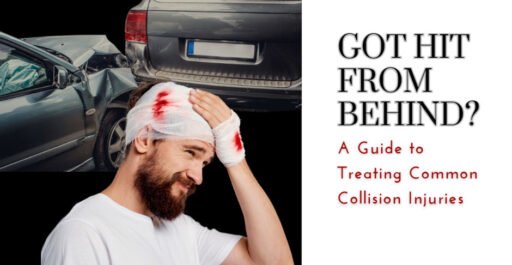You’re driving down the road, minding your own business, when BAM! You got hit from behind out of nowhere. One minute you’re jamming to your favorite tunes, the next your neck hurts, your back is killing you, and you can’t remember the last verse of the song.
Getting slammed from behind in a car accident is no joke. The physical and emotional trauma can be intense. But you don’t have to suffer in silence or let those injuries sideline you. This guide will walk you through the most common collisions injuries and how to bounce back physically and mentally stronger than ever.
With the right treatment plan and self-care regimen, you can heal properly and get back to belting out your favorite driving anthems in no time.
Whiplash and Other Neck Injuries From Rear-End Collisions
A rear-end collision can cause painful injuries to your neck like whiplash. Whiplash happens when your head is suddenly jerked backward and forward, straining the soft tissues in your neck. You may feel pain, stiffness, and limited range of motion. The good news is that whiplash often heals within a few weeks with rest, over-the-counter pain medication, and gentle stretches. Below are some tips to recover:
Resting Your Neck
The first step is to rest your neck as much as possible. Use an ice pack for 10-15 minutes at a time, a few times per day to reduce inflammation. Try sleeping on your back with a pillow under your knees and a small rolled-up towel under your neck for support. When sitting, use a lumbar support cushion for your lower back to avoid lumbar spinal stenosis and place a rolled-up towel behind your neck.
Taking an Anti-Inflammatory
An over-the-counter anti-inflammatory like ibuprofen can help relieve pain and reduce swelling in your neck muscles and soft tissues. Follow the dosage instructions on the packaging or as directed by your doctor.
Doing Gentle Exercises
Once your pain starts to improve, gentle neck stretches and exercises can help restore range of motion and strength. Slowly roll your head side to side, tilt your head to bring your ear toward your shoulder, and extend your neck to look up toward the ceiling. You can also do shoulder rolls and shrugs to loosen the muscles around your neck and upper back. Start with holding each stretch for 30 seconds and build up as tolerated.
See a doctor right away if your pain is severe or does not start to improve within a week. They may order imaging tests or physical therapy.
In rare cases, surgery may be needed to repair damaged discs or vertebrae in your spine. The most important thing is giving your neck time to heal to avoid chronic pain or limited mobility down the road. Be patient and take good care of yourself your neck will thank you.
Back Pain and Spinal Injuries After a Rear-End Crash
After you got hit from behind in an auto accident, it’s common to experience back pain, stiffness, and other spinal issues. These injuries can range from minor muscle strains to severe damage to your vertebrae, discs, and nerves.
Muscle Strains
Impact from behind can also lead to strains in your back muscles, causing aching, spasming, and difficulty moving. Rest, ice the area, and do gentle stretches. A muscle relaxant may provide relief. See a doctor for severe or persistent muscle pain.
Back Injuries
Your back can also be strained in a rear-end collision. See a doctor for any pain that radiates down your legs or arms or causes numbness. They may order imaging tests to check for disc injuries or other problems. Treatment options are similar to whiplash.
Headaches
Don’t ignore severe or persistent headaches after an accident, as they can indicate a concussion or other head injury. See your doctor right away for an exam and possibly a CT scan. They can determine if there are any serious issues and recommend treatment to relieve your symptoms.
Internal Damage
While rare, it’s possible to suffer internal injuries from being rear-ended. Seek emergency care for symptoms like abdominal pain, vomiting, or difficulty breathing. Doctors may run tests like X-rays, MRIs or CT scans to check for damage. Hospitalization and even surgery may be required to treat internal injuries from a collision.
Disc Injuries
The discs between your vertebrae act as shock absorbers for your spine. A hard collision can rupture or herniate these discs, compressing nearby nerves. This often causes sharp back pain, numbness or weakness in your legs, and difficulty walking or balancing. See a doctor right away for an MRI and possible surgery or injections to relieve pressure on your spinal cord or nerves.
Fractures
In a high-speed crash, the force can fracture your vertebrae or other back bones. You’ll experience severe, unrelenting back pain, tenderness over the fracture site, and possible nerve damage. Seek emergency care immediately for X-rays, pain management, and to stabilize the fracture. Surgery may be required to fuse or reinforce the broken bone.
No matter the specific injury, back pain from an auto accident can be debilitating. See a doctor as soon as possible for an accurate diagnosis, appropriate treatment, and to document your condition in case of a personal injury claim. With rest, physical therapy, medication, or in some cases surgery, most rear-end collision back injuries will heal over time, though some may cause chronic issues. The key is getting the right treatment right away.
Conclusion
So there you have it. Even the most minor of rear-end collisions can leave you with some pretty nasty whiplash and other injuries. Don’t let anyone tell you that it’s “just a little soreness.” Listen to your body. If the pain lingers more than a few days or you have trouble moving your neck and back, get checked out.
Physical therapy and chiropractic care can get you back on your feet quickly. And don’t forget to file a claim and contact a qualified attorney. You shouldn’t have to pay for medical bills or lost wages if the accident wasn’t your fault. Seek help from a car accident lawyer to know more. Most of all, be patient with yourself. Healing takes time. With the right treatment plan, you’ll bounce back before you know it. The road to recovery starts with that first call to the doctor. You’ve got this!





